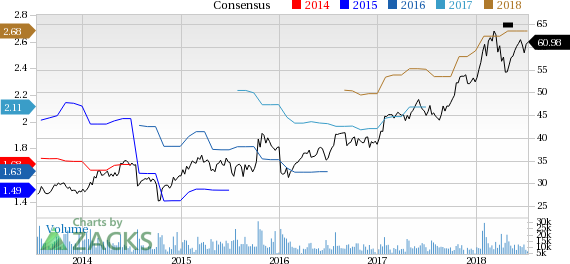In This Article:
Maxim Integrated Products, Inc. MXIM has partnered with Qualcomm Technologies, a subsidiary of Qualcomm Incorporated, to focus on safety and other important requirements for the autonomous vehicles.
Per the agreement, Maxim's Automotive Safety Integrity Level (ASIL) solutions, USB charging, next-generation gigabit multimedia serial link (GMSL) serializer and deserializer (SerDes), remote tuner and software-defined radio (SDR) technologies can now be integrated for various infotainment applications using the Qualcomm Snapdragon 820 Automotive Platform.
This will give automakers a comprehensive development platform to address the needs of automotive infotainment systems.
Maxim's SerDes technology supports the important requirements (high data rate, complex interconnect, data integrity and safety) for the future of automotive infotainment, ADAS, and autonomous driving.
Notably, shares of Maxim have returned 22.6% in the 12-month period, outperforming the industry’s rally of 12.6%.
What is Snapdragon 820 Automotive Platform?
The Snapdragon 820 Automotive Platform is an advanced automotive-grade solution designed for heterogeneous computing. Based on Qualcomm Technologies' custom-built 64-bit Qualcomm Kryo CPU, Qualcomm Adreno GPU and Qualcomm Hexagon DSP, it allows the infotainment system to receive software updates, allowing vehicles to be upgraded with the latest features, and differentiation.
Notably, Qualcomm has two Snapdragon system-on-chips designed for the automobile market, namely the 602A and 820A units. Snapdragon 820A is Qualcomm’s latest generation of automotive-grade system-on-chip, which drives infotainment and communication in vehicles.
Bottom Line
Maxim’s automotive business has been growing lately. The company invested heavily in vehicle safety technology that could prove to be foundational for a driverless car future.
Infotainment, safety and driver assistance content, known as ADAS, are long-term drivers of the automotive business. Maxim’s smart meter SOCs are increasingly replacing discrete solutions, while its infotainment, video transmission, USB ports, LED lighting and other products are witnessing notable application in the automotive segment.
The company witnessed strong growth in automotive battery management systems for electric vehicles and hybrid cars, with particular strength in China. China is expected to create more opportunities, as Chinese infrastructure spending boosts demand for its factory automation products.
We believe that the new deal will help it in gaining greater share in the automotive market and boosting top-line growth.



